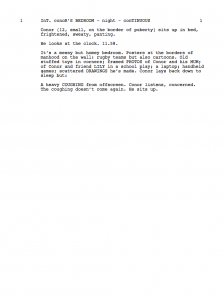

Throughout the studio, we’ve discussed formatting to great extent, is it or is it not important, what are the rules, who makes the rules, whether to capitalise, underline, italicise, or none of the above. But today I came across the perfectly infuriating example of what happens when formatting conventions are completely disregarded.
Whilst researching for my final project, I was looking for the screenplay for A Monster Calls, and the first result I found was an absolute mess: random capitalisation, pages only half filled, or even a few lines to a page. It so annoying to read, having to constantly scroll down to read the scenes, I skimmed over most of it and gave up after a few minutes. But I thought surely a screenplay so poorly formatted couldn’t possibly have been used in an actually produced film, so I did some further browsing and found a different version buried in the 2013 Blacklist, which besides some rampant underlining (shock! horror!) was more conventionally structured – and it was a much more compelling read.
It appears that the first version I found most likely wasn’t intentionally structured like that but instead was improperly exported or something along those lines. But it is a good example of why screenwriting has such a well-honed and utilised structure, which you especially miss when it’s gone.